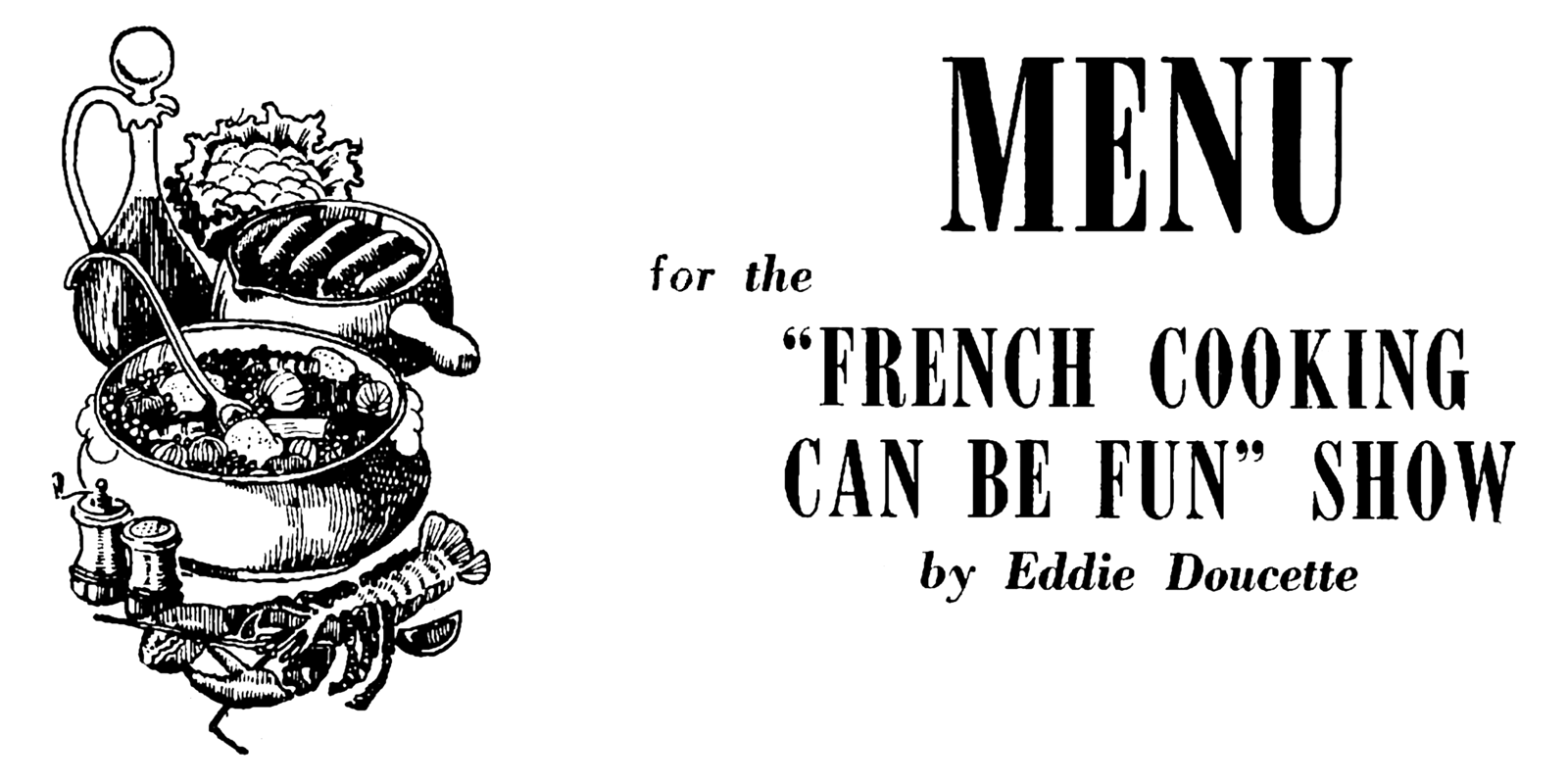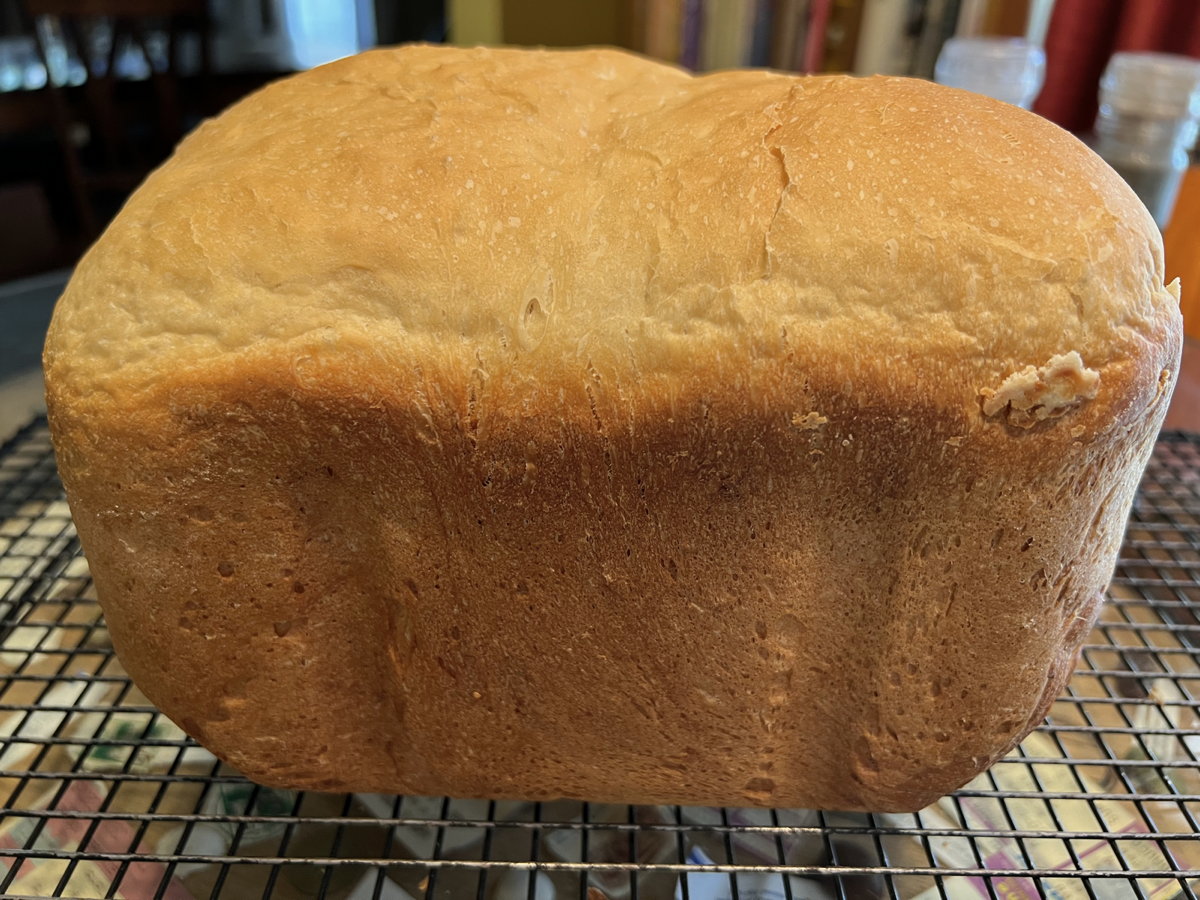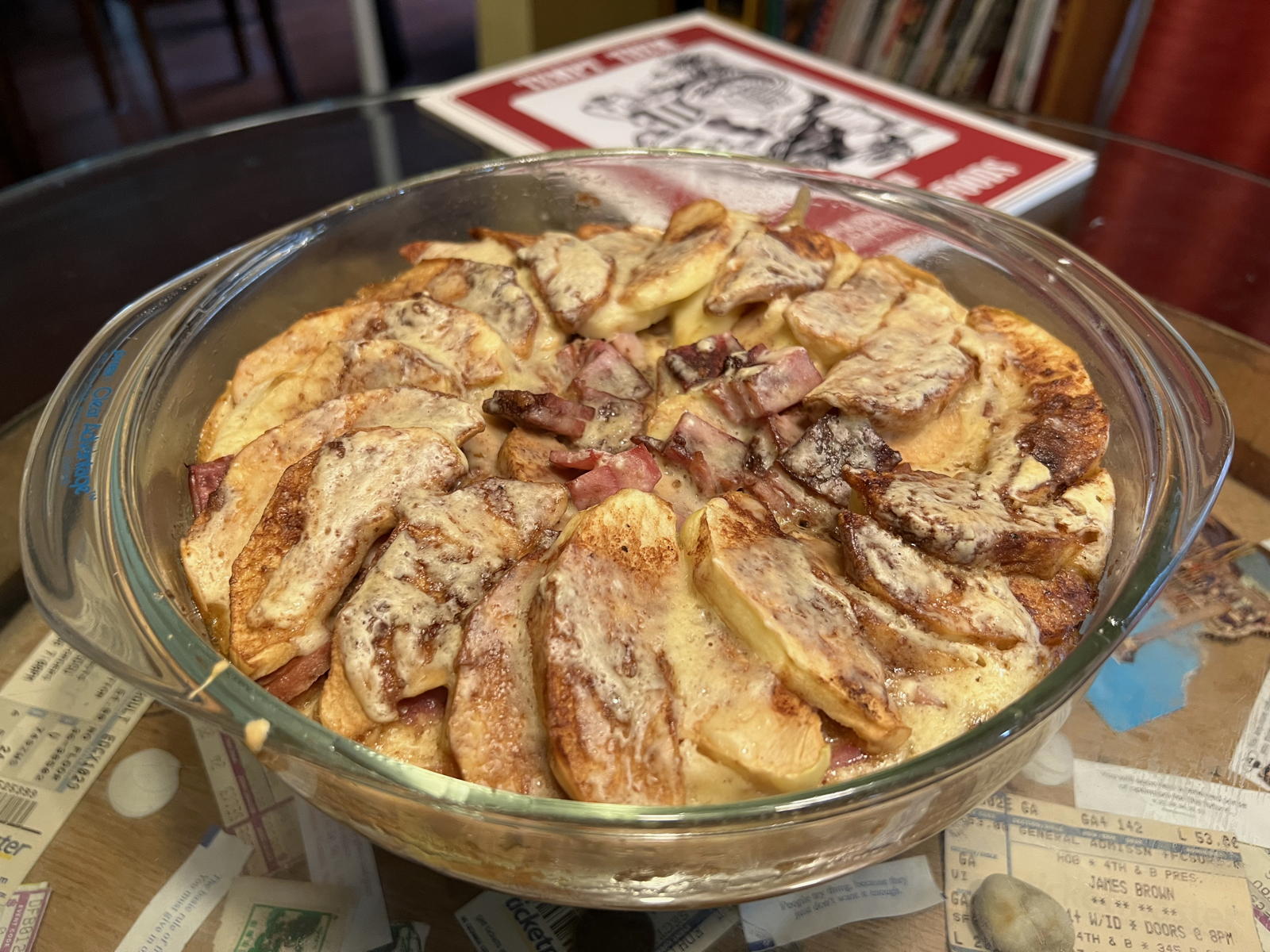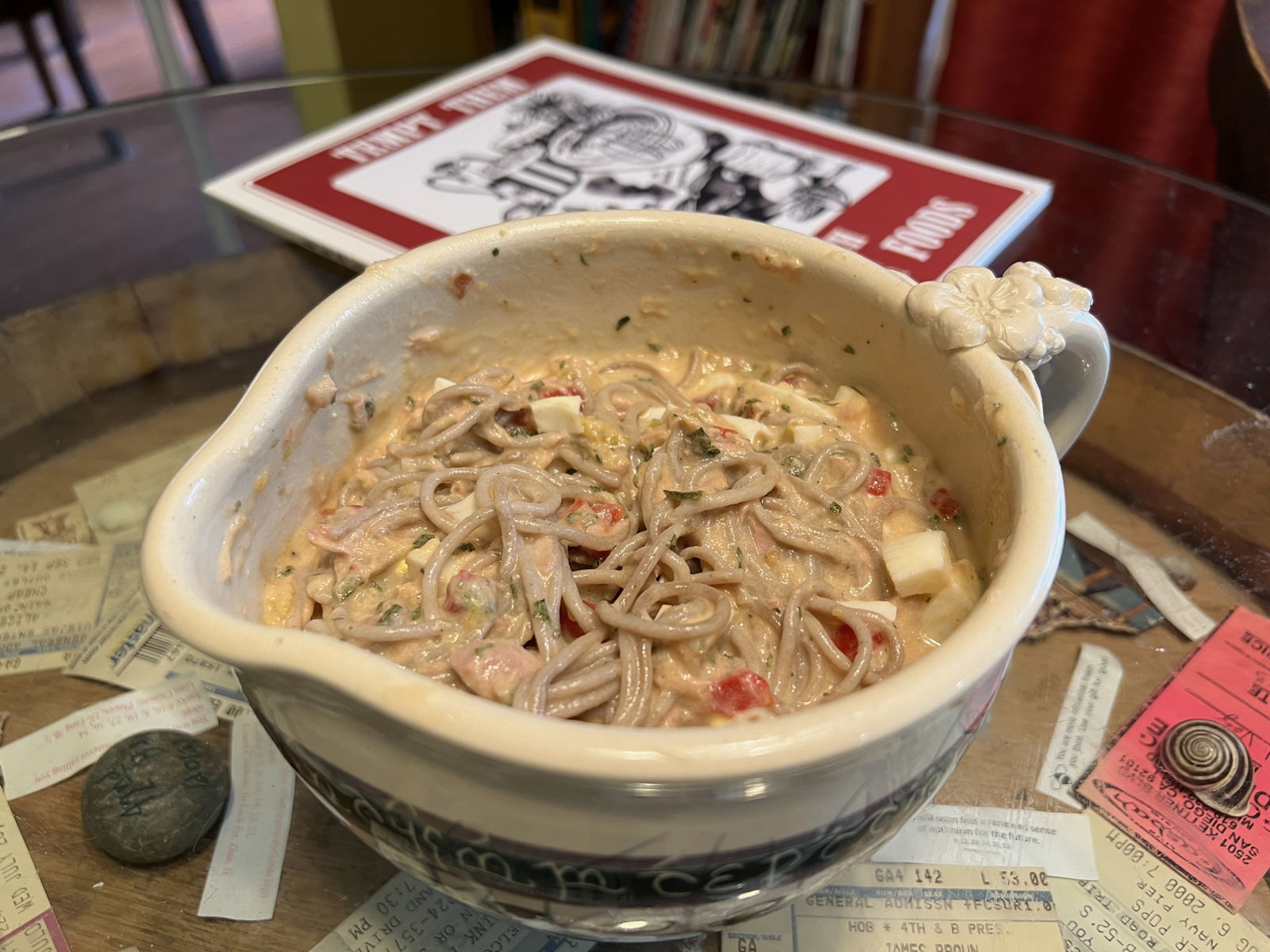Eddie Doucette recipe sampler
Tempt Them with Tastier Foods (PDF File, 13.7 MB) contains all of the Eddie Doucette recipes that I could find searching online auction sites and newspaper archives. It includes all of the recipes from the typewritten viewer notes that I wrote about earlier and a lot more. Most of the new recipes come from IGA store advertisements throughout the sixties. Despite some occasional weirdness, I’ve yet to try a recipe that wasn’t tasty. Some are amazing.
His potato bread recipe, for example, came from the pre-presentation press materials of his 1967 French Cooking Can Be Fun evening at Monticello College in Alton, Illinois. As I wrote in my announcement post, he pretty much took over the Alton Evening Telegraph for his media blitz. One of the articles was You Can Have Fun with Yeast.
With our modern mode of cooking and baking it is a pleasure to produce sumptuous light taste-provoking baked goods, whether it be for your own table, a surprise gift for a dear friend, a church social or what-have-you, I’m certain you’ll find you can have “Fun With Yeast.”
I’ve never made potato bread before, so I thought I’d try his recipe. It was amazing—and it was easy to follow, too. Normally I have to make some adjustment for kind of flour and for things the recipe-writer assumed. In this case, I made the potato-liquid mix as directed (using the potato option) and put exactly 4-½ cups (19 ounces) of sifted flour on top of it in the bread machine. With no adjustments at all, out came a perfect loaf.
I did peel the potatoes after boiling them, which is not called for in the recipe. While I prefer to leave the peel on when cooking with potatoes, I wasn’t sure how that would interact with the machine. Hand-kneading may well allow leaving the peel on. I suspect it would collect at the edges and crisp up nicely.
A potato bread doesn’t seem like a special recipe. I could have sworn I had several potato bread recipes in my community cookbooks. But according to my index, I don’t. The only potato bread recipe I could find was from the Low-Cost volume of the Southern Living collection. Doucette’s version uses more flour, shortening, sugar, and salt.
It occurred to me while writing this that I don’t have Ruth Bakalar’s 1969 The Complete Potato Cookbook indexed, and of course it also has a “white bread” made using potatoes. Bakalar’s version is much closer to Doucette’s version, but with a variable potato size. Instead of ½ cup mashed potato, it calls for 1 potato (which is also what Doucette estimated as being ½ cup) and then says to add milk to the potato to reach 1-½ cups. This matches the ½ cup potato and 1 cup milk in Doucette’s recipe.
Bakalar’s recipe is otherwise the same except that it calls for butter instead of shortening and 5 cups flour instead of 4-½ cups—but there may be an unwritten assumption that you’ll only knead in as much flour as needed.1
A previous owner of Bakalar’s book marked this recipe “Choice” and I have to agree with them. This is a wonderful white bread, for sandwiches, for peanut butter and/or jam, and for garlic bread. I suspect it would make a great bread pudding, too.
At some point, probably in 1966, Doucette also presented at a New York State Exposition Art and Home Center2 using an “all new-all gas-food demonstration kitchen”. The most intriguing recipe from his ad for the show was a New England Ham and Apple Pie.
I had it for dinner on Pi Day but it is probably more appropriate for breakfast. This is not a pie. It doesn’t hold together, and it doesn’t have a discernible crust. Because of its name, I was expecting a sort of meat pie with a layer of biscuit on top; I should have known better from the instructions:
Uncover and pour over the top, the following pancake batter: In a bowl, beat till smooth, 1 egg, ½ cup milk, 2 Tbsp. melted shortening and gradually blend in 3/4 cup sifted all-purpose flour, ¼ Tsp. salt, ½ Tsp. Baking Powder.
That really is a pancake batter, and poured over the top of ham and apples it seeps into the mix to provide texture while only leaving a barely discernible thin crust over the top layer of apples to brown. This is very different from other “New England Ham and Apple” breakfast pies which typically call for “pastry for a 2-crust pie” and put the pastry on the bottom and top.
It is a unique combination of flavors; I enjoyed it.
I also tried making a more difficult recipe. The individual ingredients for his Angel Pie Torte are easy. But assembling the meringue into a shell requires more skill than I currently have. It was fun, though.
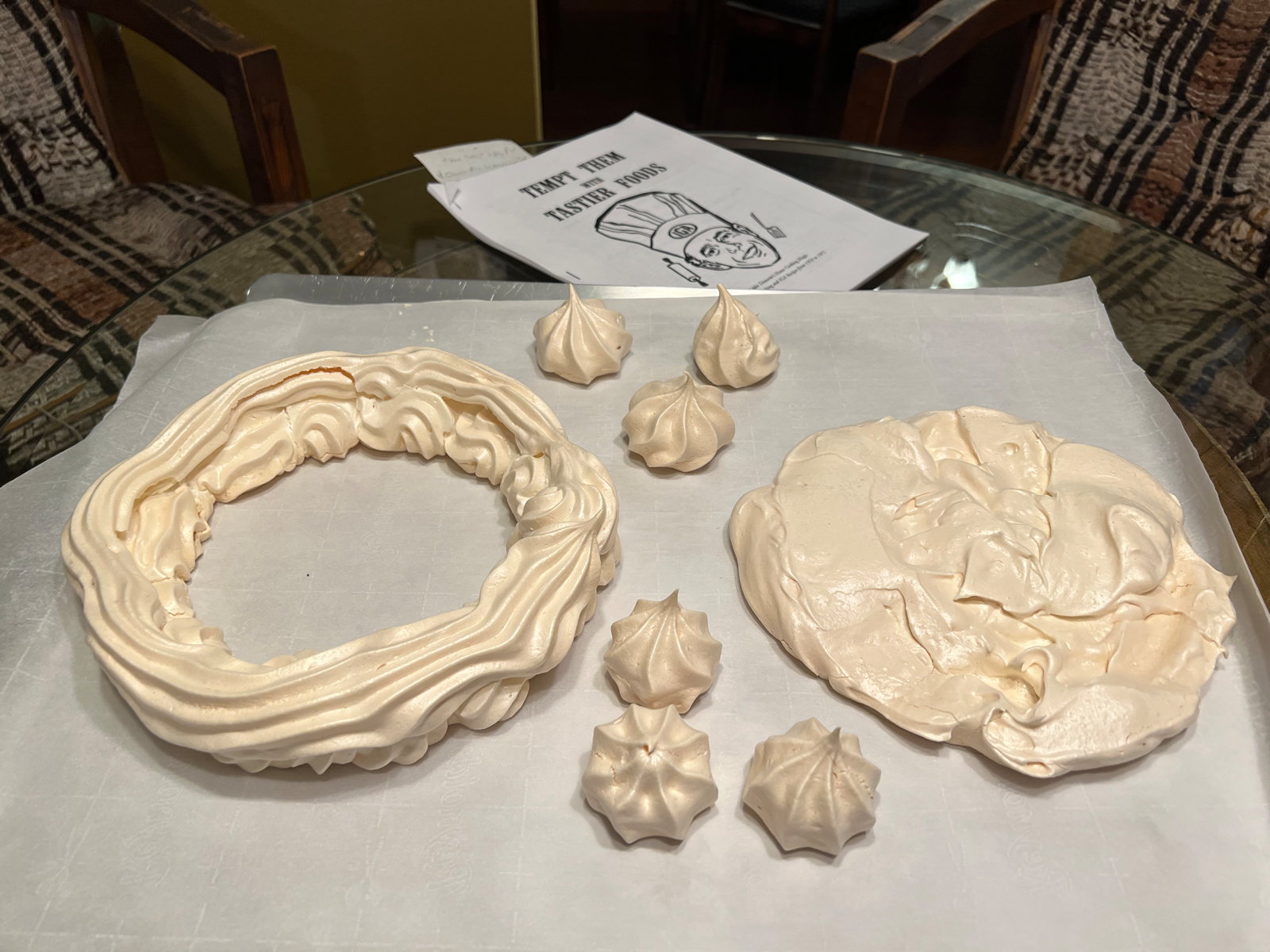
I still have a lot to learn when it comes to shaping meringue…
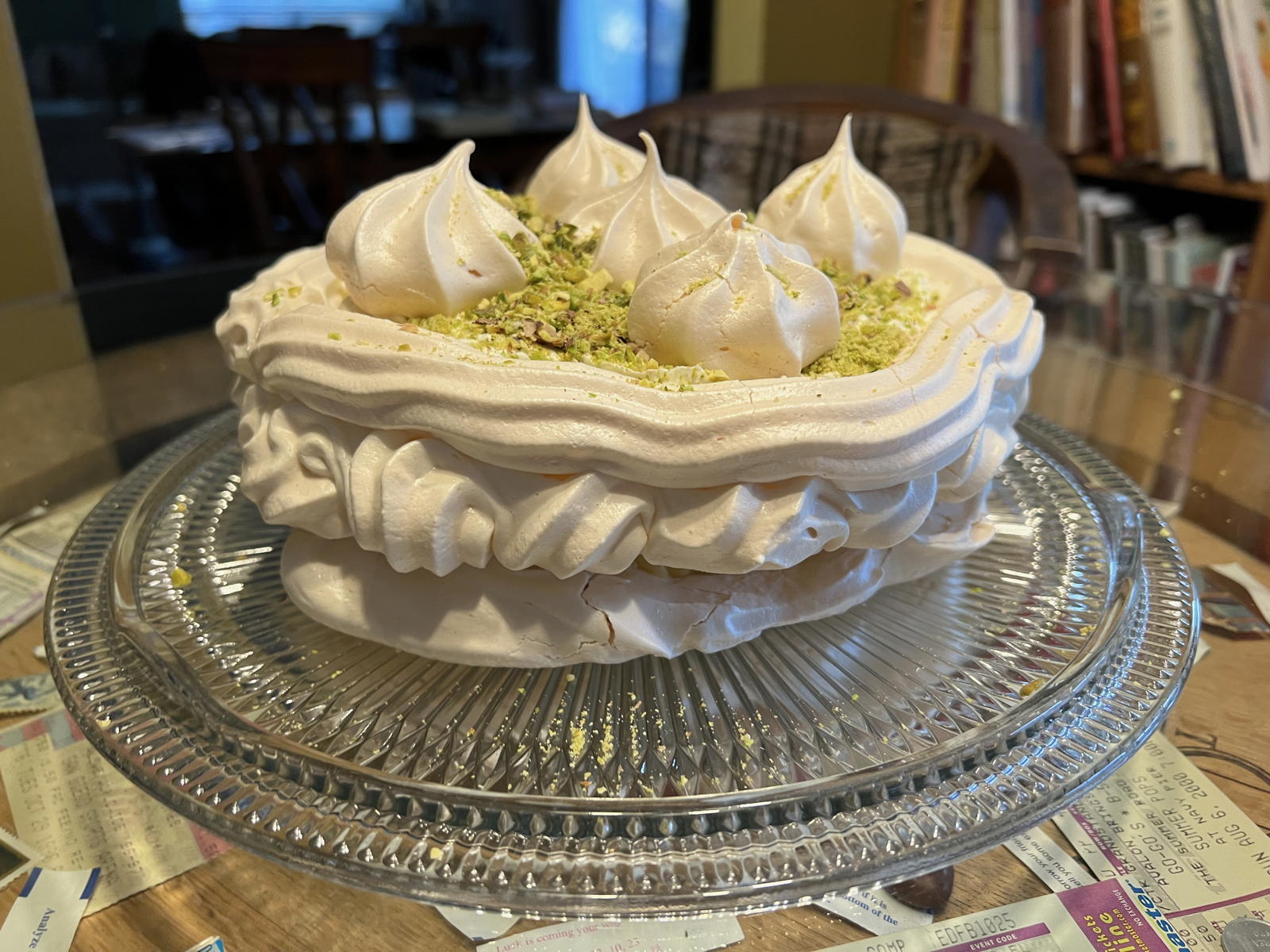
It’s the Quasimodo of Tortes.
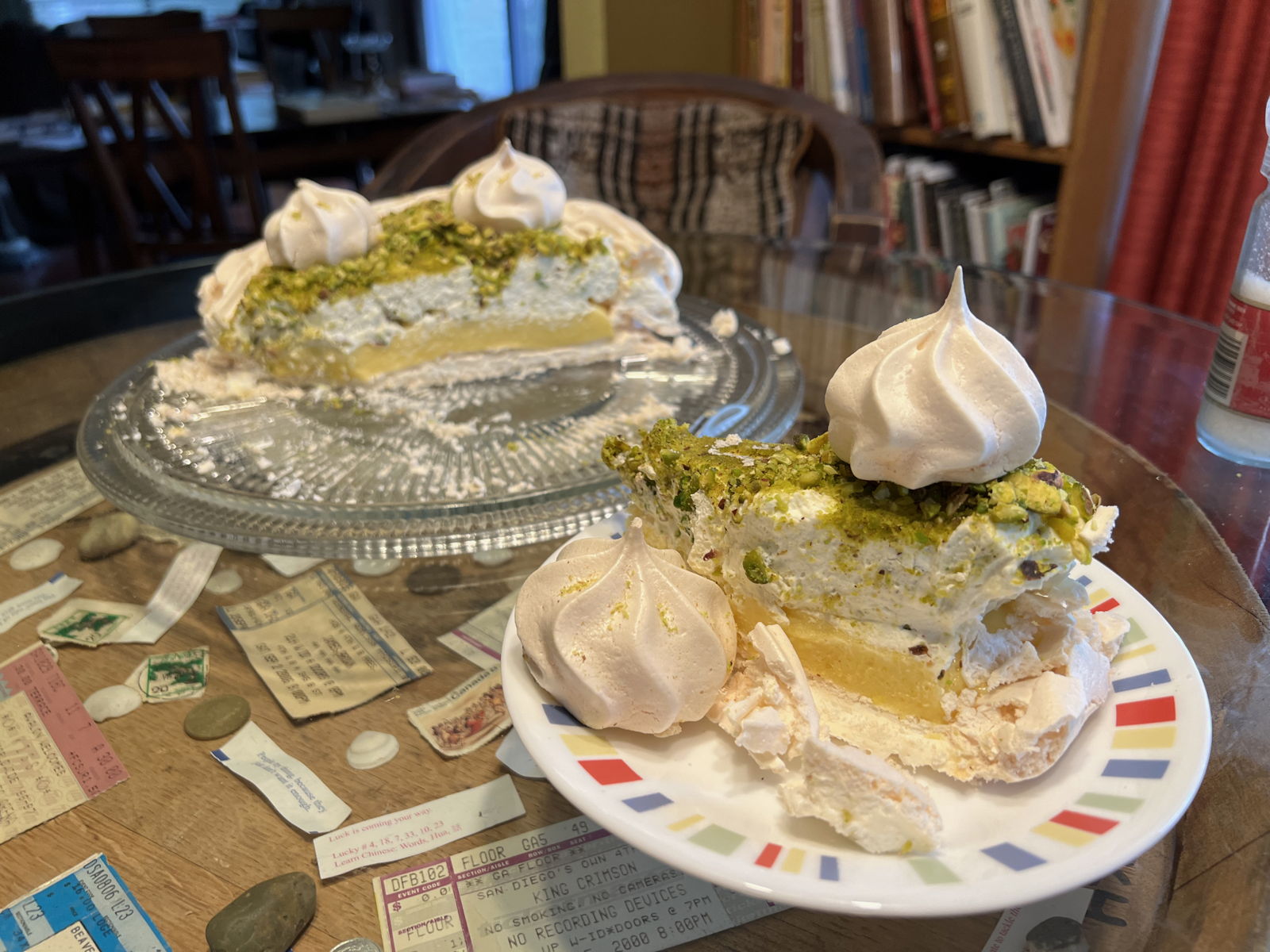
But it sure tasted good. And it was fun to make!
I used his torte instructions to modify his Chocolate Torte into a peppermint-chocolate torte. I used leftover Christmas peppermint sticks to make this for Easter.
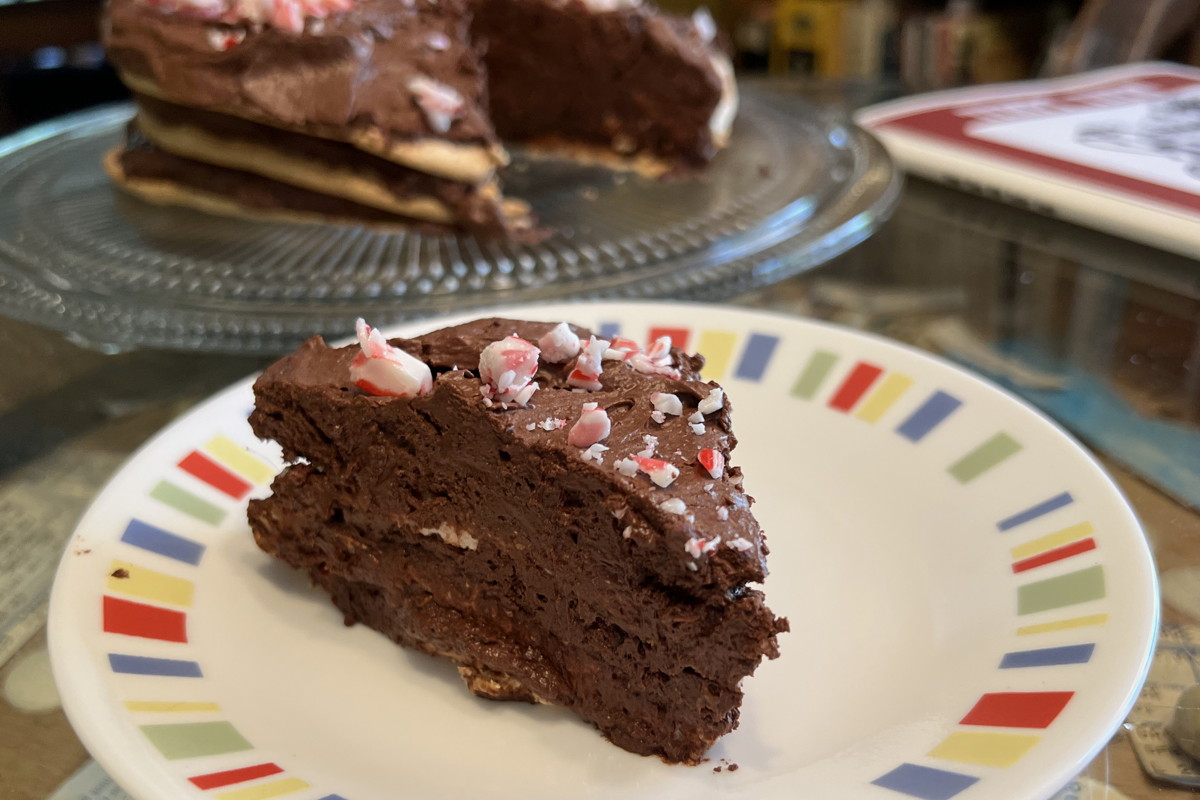
Mocha-Peppermint Torte
Servings: 12
Preparation Time: 1 hour
Eddie Doucette and Jerry Stratton
Tempt Them with Tastier Foods: An Eddie Doucette Recipe Collection
Ingredients
- Peppermint Meringue
- 4 egg whites
- ½ cup sugar
- ½ cup finely ground peppermint sticks
- ½ tsp vinegar
- ½ tsp vanilla
- Cocoa Filling
- 6 oz bittersweet chocolate
- 6 oz unsweetened chocolate
- 1 tbsp powdered instant coffee
- ¼ cup hot water
- 1 tsp vanilla
- 1 cup whipping cream
- Topping
- 2 tbsp coarsely-crushed peppermint sticks
Steps
- Meringue
- Line cookie sheet(s) with parchment paper.
- Draw three 8-inch-diameter circles on the parchment paper.
- Let egg whites rise to room temperature.
- Beat egg whites to soft peaks.
- Continue beating, adding the sugar two tablespoons at a time.
- Add vinegar and vanilla.
- Beat until meringue holds up in stiff, glossy peaks.
- Fold in the powdered peppermint.
- Fill circles with ¼ inch spread of meringue.
- Bake at 275° for 40-50 minutes until crisp.
- Carefully remove from paper to a rack to cool.
- Filling
- Dissolve the coffee in the hot water.
- Melt the bittersweet and unsweetened chocolate in a double boiler.
- Add the coffee and vanilla to the melted chocolate.
- Remove from heat and beat until creamy.
- Let cool slightly, to about 95°-100°. It will have a vaguely brownie-like texture.
- Whip the cream.
- Fold the chocolate into the cream.
- Torte
- Place bottom meringue on serving platter.
- Spread ⅓ chocolate filling over meringue.
- Place the middle meringue on top, and repeat.
- Place the top meringue on and spread with the final ⅓ chocolate filling.
- Sprinkle with coarsely-crushed peppermint.
The beer pie crust was a surprise, too. I used it for my Pi Day mango cream pie. It was wonderfully flaky—and easy—and is now one of my go-to favorites for pastry crusts.
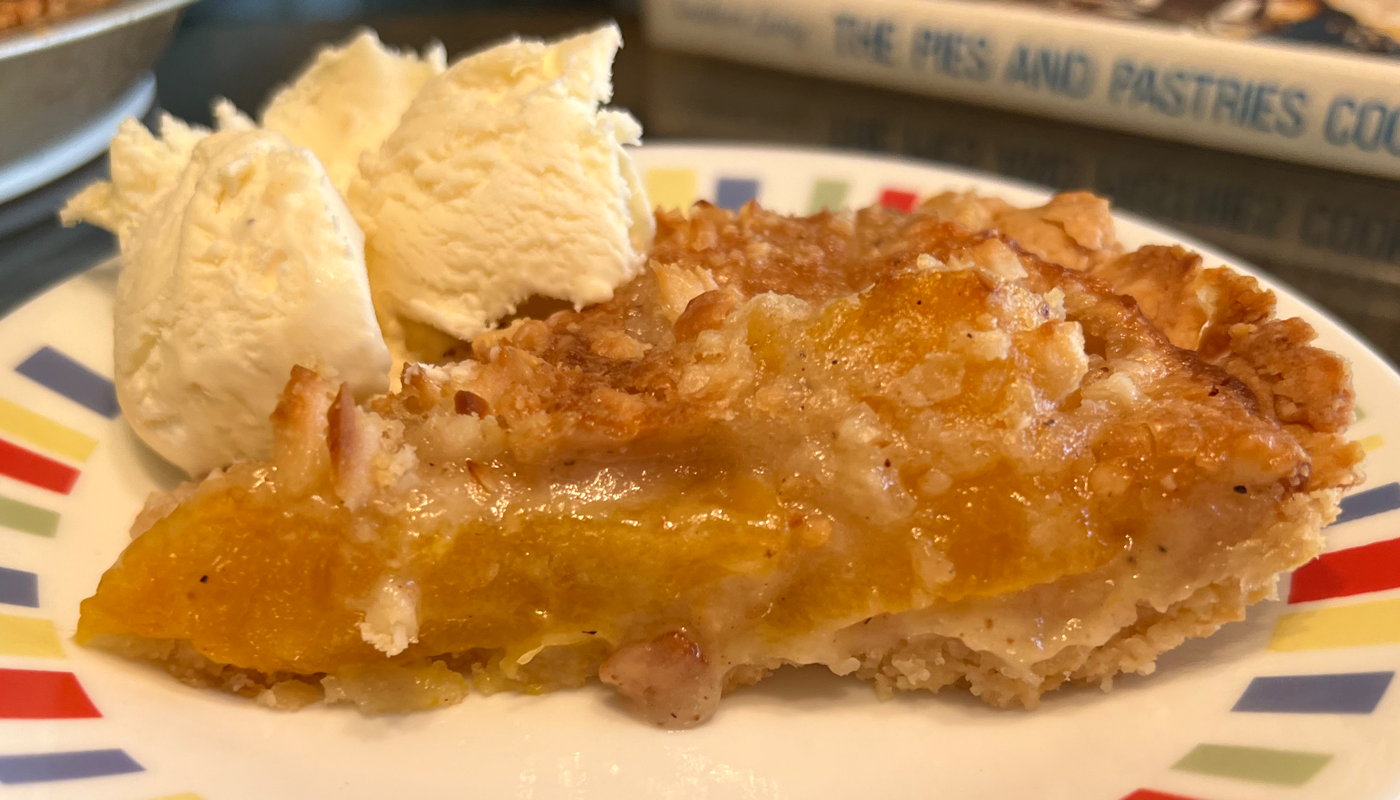
Beer Pie Crust
Servings: 12
Preparation Time: 1 hour
Eddie Doucette
Tempt Them with Tastier Foods: An Eddie Doucette Recipe Collection
Ingredients
- 1-¼ cups flour
- ½ tsp salt
- ⅓ cup (heaping) shortening
- 3 tbsp ice cold beer
Steps
- Sift flour and salt together.
- Cut in shortening with pastry blender.
- Sprinkle cold beer over mixture and toss or mix lightly until dough is moist enough to hold together.
- Refrigerate until ready to use.
- Roll out to size of pan (11" to flute edge of 9-inch pie).
For something that is both a little different from what I normally make, and a lot like what I used to see at potlucks and holiday gatherings, I made his Lenten Salad for a Friday during Lent. It calls for elbow macaroni; I used soba noodles. It makes for a far less photogenic dish, but it tasted good.
In fact, I did a lot of substitution for that salad. Instead of pickle relish, I used some homemade India relish I had open in the refrigerator, and instead of ketchup I used Sriracha. I reduced the Sriracha to about half the amount of ketchup called for.
For a very quick breakfast beverage/meal, his Orange Nog Breakfast Eye Opener is easy and delicious. It’s just blending orange juice, lemon juice, honey, and eggs into a frothy drink. I used those mason-style mugs that fit in a blender. This let me have some for breakfast when I made them, and some the next morning.
My version of the recipe doesn’t change anything in his, but it reduces it to three servings instead of nine.
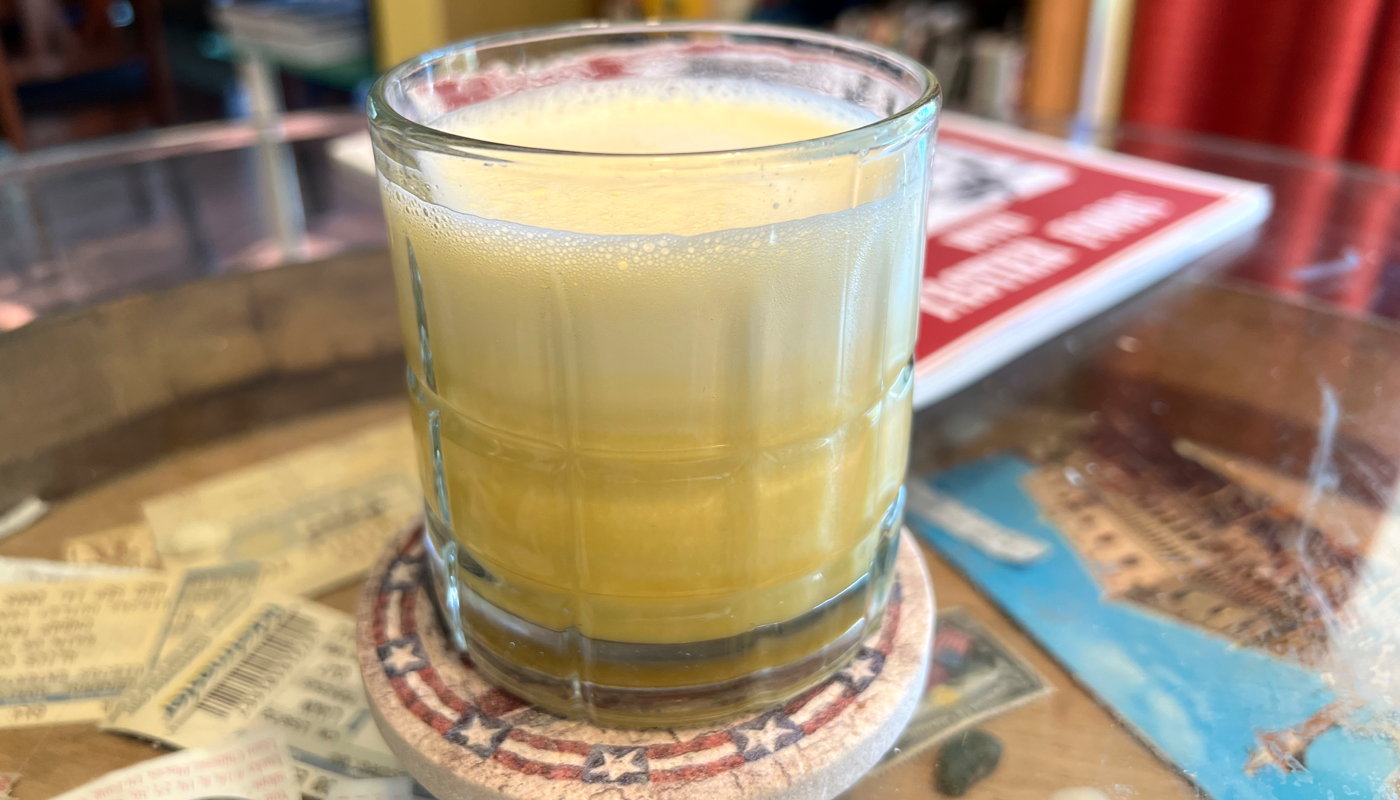
Orange Nog Breakfast Eye Opener
Servings: 3
Preparation Time: 10 minutes
Eddie Doucette
Tempt Them with Tastier Foods: An Eddie Doucette Recipe Collection
Ingredients
- 21 oz orange juice (5 oz concentrate, 16 oz water)
- 4 tsp lemon juice
- 4 tsp honey
- 1 egg
Steps
- Whip together for several seconds until frothy.
- If serving later, pour into three mason-jar cups and whip again before serving.
Why did I collect all of these recipes and go to the trouble to turn them into a book? It’s not just my collector’s mentality. These are fun recipes, and Eddie Doucette was a very able communicator of that fun. His instructions are easy to follow and the joy of creation comes through even in his terse grocery store ad recipes. Everywhere he went, he tried to spread the message that cooking can be fun, and then showed that it was true.
I published this collection because I enjoy his recipes and his style. I hope you do, too!
In response to Tempt Them with Tastier Foods: An Eddie Doucette Recipe Collection: When I get locked into a serious recipe collection, the tendency is to take it as far as I can. You can benefit from my obsession with this collection of wonderful recipes from the fifties and sixties “files of Eddie Doucette”, television personality and IGA chef.
If so, it’s counter to the plain-English reading of the text, which says to “add [flour] gradually to yeast mixture, beating with a spoon or electric mixer until the dough is too stiff to beat. Turn the dough out onto a floured board and knead in the remaining flour.” But that sort of unwritten assumption is very common in older books, and I would not be at all surprised if that assumption is present in Bakalar’s recipe as well.
↑The pamphlet isn’t dated; it does specify that it took place from Saturday, September 3 through Monday, September 5, which means that it was likely in 1960 or 1966. It is remotely possible that it was 1955. It is very unlikely to have been as early as 1949, and by 1977 he’d disappeared entirely.
↑
Eddie Doucette
- A home-cooking handful from Eddie Doucette
- A glimpse at a long-lost 1954 Chicagoland television cooking show, including recipes. They were typed by a viewer, so some of them require creative interpretation.
- Mango macadamia pie for π day
- This creamy mango pie with a macadamia nut topping is perfect for π day. Celebrate the impending end of winter with a bit of the tropics.
- Tempt Them with Tastier Foods: An Eddie Doucette Recipe Collection
- When I get locked into a serious recipe collection, the tendency is to take it as far as I can. You can benefit from my obsession with this collection of wonderful recipes from the fifties and sixties “files of Eddie Doucette”, television personality and IGA chef.
- Tempt Them with Tastier Foods: Recipes of Eddie Doucette: Jerry Stratton at My Lulu storefront (paperback)
- “Eddie Doucette was a pioneer television chef; throughout the sixties, his recipes appeared in IGA grocery store advertisements throughout North America. Tempt Them with Tastier Foods collects many of those recipes from newspaper clippings, advertisements, and live shows.”
Other Cookbooks
- The missing indexes
- Whoever decided that cookbooks don’t need indexes was never stuck hungry at one o’clock in the morning with nothing but a pepper, a tomato, and a couple of cloves of garlic, and a craving for brownies.
- Review: Favorite Recipes (A Cookbook Tastefully Done): Jerry Stratton at Jerry@Goodreads
- “This is an amazing snapshot of food in Michigan in 1981, which probably means the seventies. It’s nominally a statewide collection, but the focus is on two chapters of the Telephone Pioneers of America, the Great Lakes Chapter (based in Grand Rapids) and the Wolverine Chapter (based in Detroit).”
- Review: The Complete Potato Cookbook: Jerry Stratton at Jerry@Goodreads
- Potato stew, bread, scalloped, hash. Ruth Bakalar has you covered if you enjoy potatoes.
- Review: The Southern Living Low Cost Cookbook: Jerry Stratton at Jerry@Goodreads
- Filling dishes, from leftovers or (then) cheap ingredients. Lots of comfort food.
- The Southern Living Cookbook Library
- One of the best magazine-related cookbook series is also the one of the hardest to find. The Southern Living Cookbook Library appears to be under the radar of food writers online, but it either had a very low print run or few people want to get rid of their copies.
More Eddie Doucette
- “He Was the Chef”: Remembering Eddie Doucette, Jr.
- Eddie Doucette grew up in New England. He learned his trade in his mother’s diner, in the summer schools of New England, and in better and better restaurants throughout Vermont and Massachusetts. Then he moved to Chicago to pioneer television cooking, which is how I discovered him.
- Tempt Them with Tastier Foods: Second Printing
- The second printing of Tempt Them with Tastier Foods contains several newly-discovered Eddie Doucette recipes, as well as an interview with the chef’s son, Eddie Doucette III.
- Eddie Doucette’s Potato Bread
- This is an amazing bread for breakfast or sandwiches, easily made in a bread machine. It’s a great choice for National Sandwich Day this Friday.
- Oktoberfest Sauerkraut for Potato Day
- This simple sauerkraut casserole turns into an amazing National Potato Day treat when topped with mashed potato.
- Tempt Them with Tastier Foods: An Eddie Doucette Recipe Collection
- When I get locked into a serious recipe collection, the tendency is to take it as far as I can. You can benefit from my obsession with this collection of wonderful recipes from the fifties and sixties “files of Eddie Doucette”, television personality and IGA chef.
- Two more pages with the topic Eddie Doucette, and other related pages
More recipes
- A Traveling Man’s Cookery Book
- A Traveling Man’s Cookery Book is a collection of recipes that I enjoy making while traveling, and in other people’s kitchens.
- Tempt Them with Tastier Foods: Second Printing
- The second printing of Tempt Them with Tastier Foods contains several newly-discovered Eddie Doucette recipes, as well as an interview with the chef’s son, Eddie Doucette III.
- Looking back over 1950 in vintage cooking
- While I didn’t make my goal of trying a recipe every month in the month it was meant for, following this calendar through 2023 was an interesting experience and provided some very good food.
- Plain & Fancy in the seventies with Hiram Walker
- Enjoy a whole new world of fun, excitement and discovery in Hiram Walker Cordials, adding a personal touch to all your memorable moments and special occasions—plain or fancy!
- A Bicentennial Meal for the Sestercentennial
- Four community cookbooks celebrating the bicentennial. As we approach our sestercentennial in 2026, what makes a meal from 1976?
- Six more pages with the topic recipes, and other related pages

